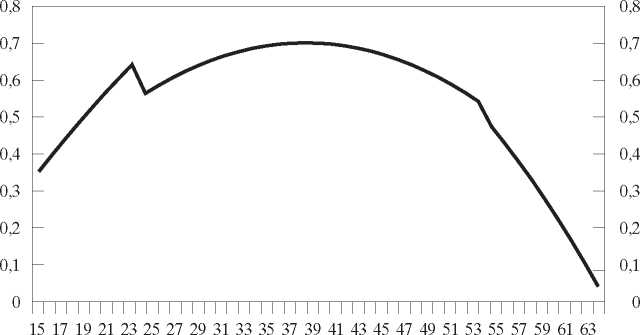Gerontocracy in Motion?
27
Figure 6
Age-Employment Probability Profile in EU-15 Countries
Deviation of mean employment probability in %-points

Authors’ calculations from ECHP.
Age in Years
RWI
ESSEN
of the estimated marginal effects, with t-values greater than 1.96 indicating sta-
tistically significant estimates at a 95 % confidence level.
Before we address the issue of generational crowding, we briefly discuss our
results regarding the included covariates. Throughout the EU women display
considerably lower employment rates, with a point estimate of nearly 27 per-
centage points. Clearly, highly educated individuals are much more likely to be
employed than individuals with medium or even low education. These dis-
crepancies are less pronounced for men, providing an indication for the rele-
vance of participation issues for the labor market behavior of women. Simi-
larly, disabled men experience disproportionately low employment rates. This
pattern is quite consistent with a voluntary withdrawal of women from the la-
bor force in case of health problems.
Regarding the life-cycle profile of employment rates, our estimates indicate
that an initial phase of increasing employment propensities - individuals final-
izing their human capital investments and entering the labor market - is typi-
cally followed by a plateau phase of labor force participation and employment
during core-age years and then by a pronounced decline in employment prob-
abilities for the oldest age-group (55-64 years). This estimated life-cycle pat-
tern is depicted graphically in Figure 6.
Our emphasis is on the variables measuring demographic change, reported in
Table 3. Regarding the independent effect of cohort size, our estimation re-
More intriguing information
1. The name is absent2. What Contribution Can Residential Field Courses Make to the Education of 11-14 Year-olds?
3. The name is absent
4. TINKERING WITH VALUATION ESTIMATES: IS THERE A FUTURE FOR WILLINGNESS TO ACCEPT MEASURES?
5. Temporary Work in Turbulent Times: The Swedish Experience
6. The name is absent
7. The name is absent
8. Migration and employment status during the turbulent nineties in Sweden
9. Geography, Health, and Demo-Economic Development
10. Ruptures in the probability scale. Calculation of ruptures’ values